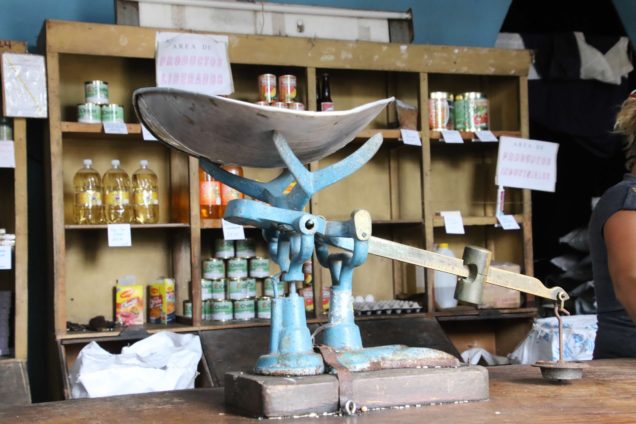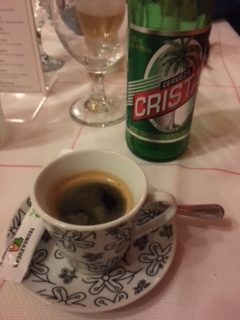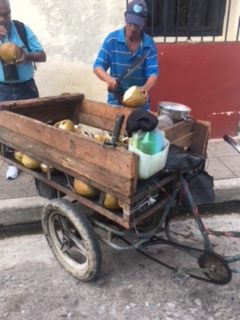There Are Mangos Everywhere: a brief Cuban travel story of cockroaches, coconuts and Cuba Libres
Gastronomy student Mollie Braen recently traveled to Cuba and contributed this post.

We were strolling down the busy, narrow streets of Havana, nine days into our Cuban adventure, and in all honesty, we were tired. We had experienced record-breaking rain, with cars floating down the streets of Trindad. We saw locals standing in knee deep water in their homes, cows and horses stranded on the side of the road. We had locked ourselves out of our bathroom in the hotel in Remedios because two giant cockroaches had made a home in our bathtub and we had experienced what a ration store was like for local Cubans, with a mystery meat sitting out on the hot counter and a little kitten sick with some kind of infections trying to stay cool among the coffee bean sacks. As we realized that not only were we very lost in a city we did not know, we were hungry and hot beyond anything we had ever felt before.
 Cuba is an interesting place. This is how I start every conversation when someone asks, “So, how was Cuba?” I say it was everything and nothing like I imagined. It is beautiful, hot, exhausting, exciting, heart-breaking but most of all, heart-filling. The people are kind and friendly. They welcomed us into their homes and art studios, showing us their pride for their country but also their humanity, as they are people just like us.
Cuba is an interesting place. This is how I start every conversation when someone asks, “So, how was Cuba?” I say it was everything and nothing like I imagined. It is beautiful, hot, exhausting, exciting, heart-breaking but most of all, heart-filling. The people are kind and friendly. They welcomed us into their homes and art studios, showing us their pride for their country but also their humanity, as they are people just like us.
The food, in all honesty, was not very diverse or flavorful. This is mostly due to how tourism and the restaurant businesses work in Cuba today. We mostly ate at government run hotels or restaurants and when we ate at a local Paladar, a type of restaurant in a person’s home, it was always a similar meal. It started with a salad of cabbage, canned green beans and beets, the main dishes were often pork or chicken, sometimes shrimp, with rice and black beans, and a choice between Bucanero or Cristal, the two local government produced beers for a drink. Dessert is usually served and it is either flan or some kind of pudding, and occasionally ice cream (which is reserved for tourists, as most of Cuba’s dairy is imported from other countries). The drinks are always plentiful: Cuba Libre, which is coke and rum, Mojitos with Cuban rum, or sometimes just rum. These are delicious, especially after a heat and humidity so intense, I would have sworn my bones were sweating.
 We sampled fresh coconut sold by a man with a machete and cart near a square in Camaguey, and while it was somewhat bitter and gummy it felt like a much-needed hydration snack. We watched as a man showed us how Cuban cigars are made, rolling it by hand and telling the infamous story of how the Cuban sandwich came to be, using a cigar press in Miami many years ago. We ate fresh mangos everywhere we went. The country is filled with trees and an abundance so large, they barely sell them anymore, as they lay upon the ground, juicy, drippy and delicious for anyone to pick up and bite right into (make sure to spit out the skin).
We sampled fresh coconut sold by a man with a machete and cart near a square in Camaguey, and while it was somewhat bitter and gummy it felt like a much-needed hydration snack. We watched as a man showed us how Cuban cigars are made, rolling it by hand and telling the infamous story of how the Cuban sandwich came to be, using a cigar press in Miami many years ago. We ate fresh mangos everywhere we went. The country is filled with trees and an abundance so large, they barely sell them anymore, as they lay upon the ground, juicy, drippy and delicious for anyone to pick up and bite right into (make sure to spit out the skin).
So, at that moment, on the busy Havana street, where we were lost and tired, and honestly, a bit homesick, a man on a bicycle walked it by. Hanging from the handlebar of his bike was a very large pig leg. As he walked by, the leg slightly grazed the ground and I could not help but just laugh at the sheer unordinary happenstance that we had just witnessed in front of us. This story is the best one I tell of our trip because it encompasses the resourcefulness of Cuba, the tough, the ingenious, the exciting, the different, and the difficult. Cuba was a place like nowhere else I have ever been and though the food was not what I expected, it was not always about what we ate but I will always remember what we saw and what we experienced within the food culture and foodways of this incredibly interesting country we were so lucky to visit.